



Flowmeter is an instrument used to measure the linear, nonlinear, mass or volume flow of liquid or gas. It can be used to measure the flow of media such as gas, liquid, steam, etc.
1. Orifice flow meter

Working principle: When the fluid fills the pipeline and flows through the throttling device in the pipeline, the flow beam will shrink locally, thereby increasing the flow rate and lowering the static pressure. Therefore, a pressure drop, i.e., pressure difference, is generated before and after the throttling device. The greater the flow rate of the medium, the greater the pressure difference generated before and after the throttling device. Therefore, the orifice flowmeter can measure the size of the fluid flow by measuring the pressure difference. This measurement method is based on the law of conservation of energy and the law of flow continuity.
Working characteristics: The throttling device has a simple and firm structure, stable and reliable performance, long service life and low price; it has a wide range of applications and can measure all single-phase flows and some mixed-phase flows; the standard throttling device can be put into use without actual flow calibration; the integrated orifice plate is easier to install and does not require a pressure pipe, so it can be directly connected to a differential pressure transmitter and a pressure transmitter.
2. Electromagnetic flow meter

Working principle: Based on Faraday's law of electromagnetic induction. In the electromagnetic flowmeter, the conductive medium in the measuring tube is equivalent to the conductive metal rod in the Faraday test. The two electromagnetic coils at the upper and lower ends generate a constant magnetic field. When the conductive medium flows through, an induced voltage is generated. The two electrodes inside the pipe measure the induced voltage. The measuring pipe is electromagnetically isolated from the fluid and the measuring electrode through a non-conductive lining (rubber, Teflon, etc.).
Working characteristics: It has a bidirectional measurement system; the straight pipe section required by the sensor is short, which is 5 times the pipe diameter; the pressure loss is small; the measurement is not affected by changes in fluid density, viscosity, temperature, pressure and conductivity; it is mainly used in sewage treatment.
3. Turbine flow meter
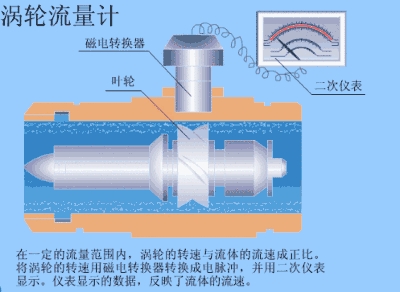
Working principle: Within a certain flow range, the speed of the turbine is proportional to the flow rate of the fluid. The fluid flow drives the turbine to rotate, and the speed of the turbine is converted into electrical pulses, which are displayed by a secondary meter to reflect the fluid flow rate.
Working characteristics: strong resistance to impurities; strong resistance to electromagnetic interference and vibration; simple structure and principle, easy to maintain; almost no pressure loss, saving power consumption.
4. Venturi flow meter
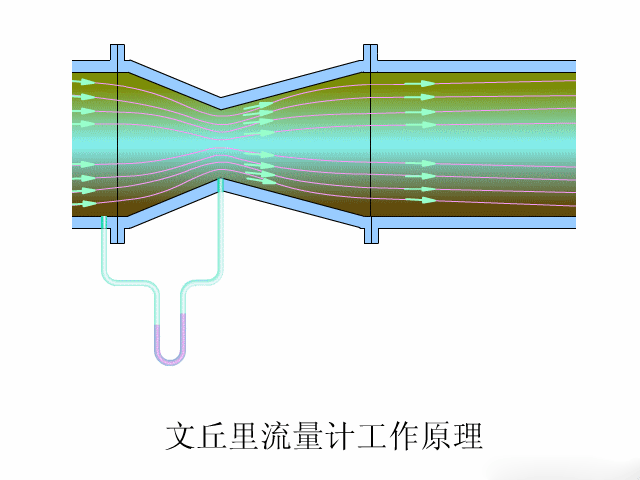
Working principle: When the fluid flows through the throttling device in the Venturi flowmeter pipeline, the flow velocity initially forms a local contraction at the Venturi throttling device, resulting in an increase in flow velocity and a decrease in static pressure difference. A static pressure difference is generated before and after the Venturi flowmeter. The greater the fluid flow rate, the greater the static pressure difference. The flow rate is measured based on the pressure difference.
Working characteristics: no abrasion and dirt accumulation problems, and can have a certain rectification effect, with high measurement accuracy and stability.
5. Positive displacement flow meter
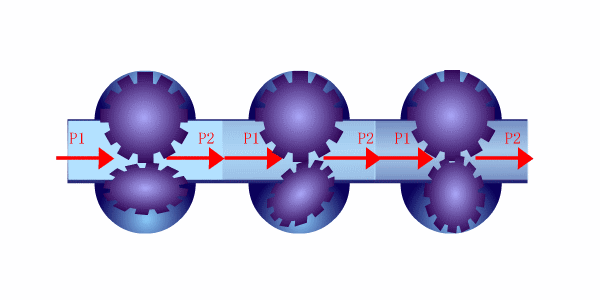
Working principle: when the fluid passes through the flowmeter, a certain pressure difference will begenerated between the inlet and outlet of the flowmeter. The rotating part of the flowmeter (referred to asthe rotor) rotates under the action of this pressure difference and discharges the fluid from the inlet to theoutlet. In this process, the fluid fills the "metering space" of the flowmeter again and again, and then iscontinuously sent to the outlet. Under given flowmeter conditions, the volume of the metering space isdetermined. As long as the number of rotations of the rotor is measured, the cumulative yalue of the yolumeof the fluid passing through the flowmeter can be obtained.
Working characteristics: high metering accuracy; installation pipeline conditions have no effect on metering accuracy; can be used to measure high-viscosity liquids; wide range; direct-reading instruments can directly obtain cumulative and total amounts without external energy, which is clear and easy to operate; complex structure and large size, not suitable for high and low temperature occasions; most instruments are only suitable for clean single-phase fluids; large noise and vibration.
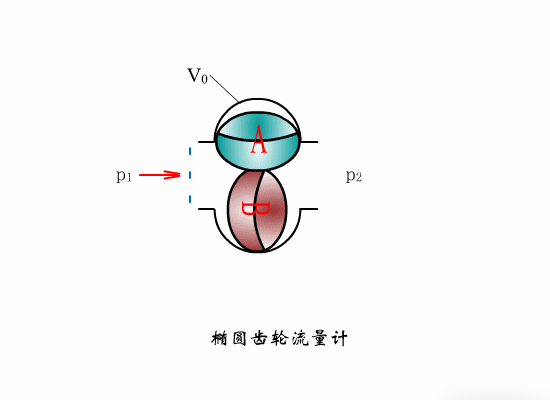
Working principle: When the measured liquid enters the flowmeter through the pipeline, the pressure difference generated at the inlet and outlet drives a pair of gears to rotate continuously, constantly transporting the liquid measured by the crescent-shaped cavity to the outlet. The product of the number of revolutions of the elliptical gear and four times the displacement each time is the total flow rate of the measured liquid.
Working characteristics: Flow measurement has nothing to do with the flow state of the fluid; the higher the viscosity of the medium, the smaller the leakage from the gap between the gear and the metering space. Therefore, the higher the viscosity of the measured medium, the smaller the leakage error, which is more beneficial to the measurement; the oval gear flowmeter has high metering accuracy and is suitable for measuring the flow of high-viscosity media, but is not suitable for fluids containing solid particles (solid particles will jam the gears, making it impossible to measure the flow). If there is gas mixed in the measured liquid medium, it will also cause measurement errors.
7. Rotor flow meter
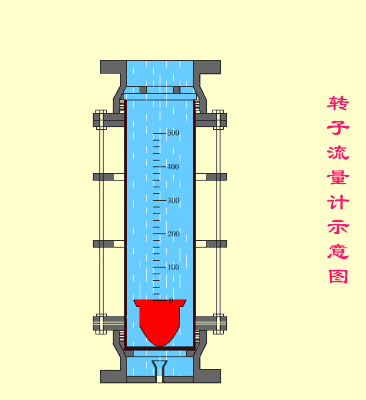
Working principle: When measuring the flow rate of a fluid, the measured fluid flows in from the lower end of the tapered tube. The flow of the fluid impacts the rotor and generates a force on it. When the flow rate is large enough, the generated force lifts the rotor. At the same time, the measured fluid flows through the annular section between the rotor and the tapered tube wall. At this time, there are three forces acting on the rotor: the dynamic pressure of the fluid on the rotor, the buoyancy of the rotor in the fluid, and the gravity of the rotor itself. When the flowmeter is installed vertically, the center of gravity of the rotor coincides with the axis of the tapered tube, and the three forces acting on the rotor are all in a direction parallel to the axis of the tube. When these three forces are balanced, the rotor floats steadily at a certain position in the tapered tube. For a given rotor flowmeter, the size and shape of the rotor have been determined, so its buoyancy and its own gravity in the fluid are known constants. Only the dynamic pressure of the fluid on the float changes with the flow velocity. Therefore, when the incoming flow velocity increases or decreases, the rotor will move up or down, and the flow cross-sectional area at the corresponding position will also change until the flow velocity becomes the corresponding speed when balanced, and the rotor will stabilize at the new position. For a given rotor flowmeter, the position of the rotor in the cone tube has a one-to-one correspondence with the flow rate of the fluid flowing through the cone tube.
Working characteristics: It has the characteristics of simple structure, intuitiveness, small pressure loss and easy maintenance; the rotor flowmeter is suitable for measuring the diameter of the pipeline.
8. Vortex flowmeter

Vortex flowmeter is a meter that places a non-streamlined vortex generator in the fluid, and the fluid is alternately separated on both sides of the generator to release two strings of regularly staggered vortices. Vortex flowmeters can be divided into stress type, strain type, capacitance type, thermal type, vibration type, photoelectric type and ultrasonic type according to the frequency detection method.
Working characteristics: simple and firm structure, no moving parts, high reliability, and very reliable long-term operation; simple installation and convenient maintenance; the detection sensor does not directly contact the measured medium, with stable performance and long life; the output is a pulse signal proportional to the flow rate, without zero drift and high accuracy; wide measuring range, with a range ratio of up to 1:10; small pressure loss, low operating costs, and more energy-saving significance.
9. Rotary flow meter
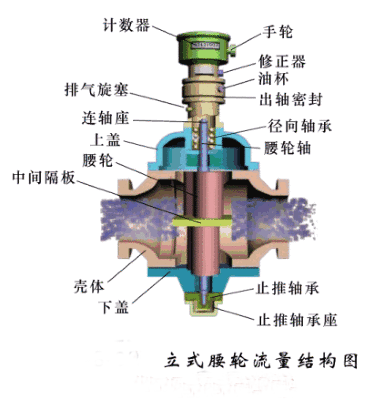
Working principle: When fluid passes through the flow meter, the two wheels will rotate in the positive direction under the action of the differential pressure of the fluid at the inlet and outlet of the flow meter. The liquid in the metering chamber will flow in and out continuously. The fluid flow rate can be calculated by knowing the volume of the metering chamber and the number of times the wheels rotate.
Working characteristics: It is suitable for flow measurement of various clean liquids, especially for oil metering, and can also be made into a flow meter for measuring gas. It has high accuracy, up to 0.1-0.5 level, small pressure loss and large measuring range.
10. Dual rotor flow meter

Working principle: The small pressure difference between the inlet and outlet drives the rotor to rotate. At the same time, each rotor is subjected to different rotational torques of the fluid on the same cross section, but the combined torques of the rotational torques on all cross sections of the two rotors are equal. Therefore, the two rotors rotate at the same speed and torque, and the displacement is balanced without pulsation. The spiral rotor can output 8 times the volume of the cavity for each revolution. Therefore, the number of revolutions of the rotor is proportional to the cumulative flow of the fluid, and the speed of the rotor is proportional to the instantaneous flow of the fluid. The number of revolutions of the rotor is transmitted to the meter counter through the magnetic coupling, showing the flow rate flowing through the flowmeter (flowing through the pipeline).
Working characteristics: Suitable for thin oil, light oil, heavy oil, crude oil with high sand content and high water content, and the viscosity range of the measured liquid is wide; the flow meter has a large liquid flow rate; long service life, high accuracy, strong reliability; extremely small internal pressure loss; can be directly connected to the computer network.
11. Target flow meter

Working principle: When the fluid flows, a force is generated on the target plate, causing the target plate to produce a slight displacement. The displacement is related to the flow rate. The flow rate is calculated based on the relationship between the displacement and the flow rate.
Working characteristics: The whole instrument has a solid structure without moving parts, plug-in structure, and easy disassembly; a variety of corrosion-resistant and high and low temperature resistant materials can be selected (such as Hastelloy, titanium, etc.); the whole machine can be made into a fully sealed without dead angle (welded form), without any leakage points, and can withstand 42MPa high pressure; the instrument has a self-check program inside, and the fault phenomenon is clear at a glance; the sensor does not contact the measured medium, there is no wear of parts, and it is safe and reliable to use; it can accurately measure various gas and liquid flow under normal temperature, high temperature 500 degrees, and low temperature -200 degrees.
12. Ultrasonic flow meter

Working principle: Ultrasonic flowmeter measures liquid flow by detecting the effect of fluid flow on ultrasonic waves, which uses the "time difference method". First, probe 1 is used to transmit a signal, which passes through pipe wall 1, fluid, pipe wall 2 and is received by probe 2 on the other side; while probe 1 is transmitting a signal, probe 2 also transmits the same signal, which passes through pipe wall 2, fluid, pipe wall 1 and is received by probe 1; due to the existence of flow velocity, the two times are not equal, and there is a time difference, so the flow velocity can be obtained based on the time difference, and then the flow value can be obtained.
Working characteristics: It can measure the flow rate of conventional pipelines, and can also measure the flow rate of pipelines that are difficult to observe and difficult to touch; it can not only measure the flow rate of conventional fluids, but also measure the flow rate of fluids with strong corrosive, radioactive, flammable, explosive and other characteristics. However, ultrasonic flowmeters have some limitations on the temperature range of the measured fluid. At present, ultrasonic flowmeters in my country can only be used to measure fluids below 200°C; moreover, the measurement circuit of ultrasonic flowmeters is quite complicated and has high requirements for the measurement circuit.
13. Nozzle flow meter
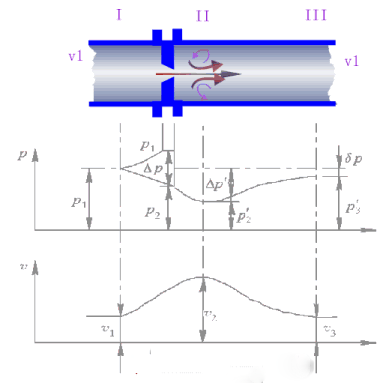
Working principle: The measurement principle of the nozzle is based on the throttling principle of fluid mechanics. When the fluid filling the pipe flows through the nozzle in the pipe, the flow velocity will form a local contraction at the nozzle, thereby accelerating the flow velocity and reducing the static pressure. As a result, a pressure drop or pressure difference is generated before and after the nozzle. The greater the flow rate of the medium, the greater the pressure difference generated before and after the nozzle. Therefore, the size of the fluid flow can be measured by measuring the pressure difference.
Working characteristics: simple structure and easy installation; the nozzle has less pressure loss than the orifice plate and requires a shorter straight pipe section; no actual flow verification is required and the performance is stable; it can withstand high temperature and high pressure and impact; it has better corrosion resistance than the orifice plate and has a long service life; it has high accuracy, good repeatability and stable outflow coefficient; the arc-shaped structure design can measure various liquids, gases, steam and various dirty media; it uses overall forging processing technology and has a higher cost.
14. Coriolis mass flow meter
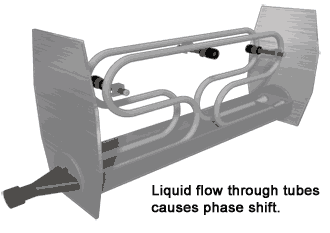
Coriolis mass flowmeter, (Coriolis Mass Flowmeter), is referred to as Coriolis flowmeter.
Working principle: When a particle in a rotating system moves toward or away from the center of rotation, an inertial force will be generated. By directly or indirectly measuring the Coriolis force acting on the rotating pipe by the fluid flowing in the pipe, the mass flow rate of the fluid through the pipe can be measured.
Working characteristics: Coriolis mass flowmeter directly measures mass flow with high measurement accuracy. It can measure a wide range of fluids, including various liquids with high viscosity, slurries containing solids, liquids containing trace gases, and medium and high pressure gases with sufficient density. The vibration amplitude of the measuring tube is small and can be regarded as a non-moving part. There are no obstructions and moving parts in the measuring pipeline. It is more sensitive to external vibration interference. In order to prevent the influence of pipeline vibration, the flow sensor of most models of Coriolis mass flowmeters has high requirements for installation and fixation.